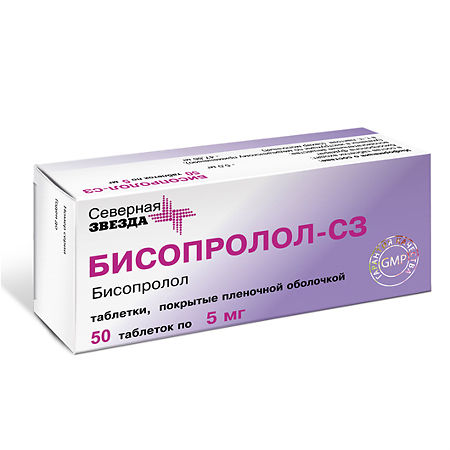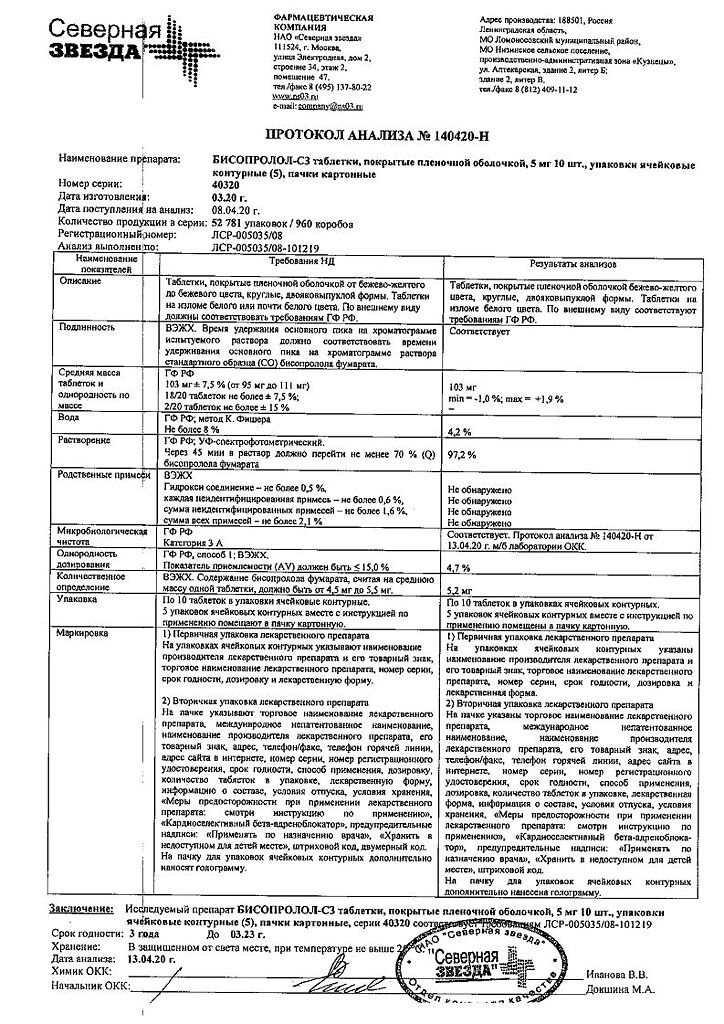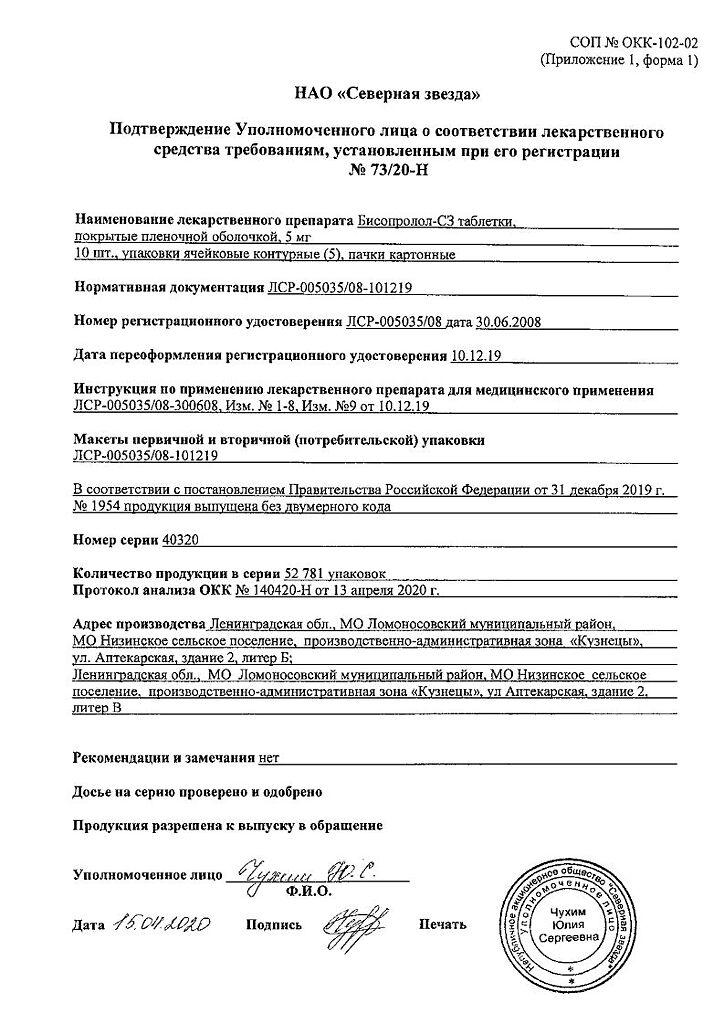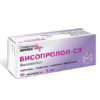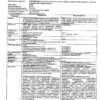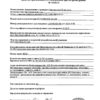No products in the cart.
Bisoprolol-SZ,5 mg, 50 pcs.
€1.00
Out of stock
(E-mail when Stock is available)
Description
A selective betahadrenoblocker, without its own sympathomimetic activity, has no membrane stabilizing effect. It reduces plasma renin activity, decreases myocardial oxygen demand, decreases heart rate (HR) (at rest and under load).
It has hypotensive, antiarrhythmic and anti-anginal action. By blocking in low doses betahadrenoreceptors of the heart, it decreases catecholamine-stimulated cAMP formation from ATP, decreases intracellular calcium ion current, has negative chrono-, dromo-, batmo- and inotropic effects, inhibits conduction and excitability and decreases atrioventricular conduction.
If the dose is increased above the therapeutic dose, it has a beta2-adrenoblocating effect.
The total peripheral vascular resistance increases at the beginning of drug administration, in the first 24 h (as a result of reciprocal increase of alpha-adrenoreceptor activity and elimination of beta2-adrenoreceptor stimulation) which returns to baseline in 1-3 days and decreases with long-term administration.
The hypotensive effect is associated with decreased minute blood volume, sympathetic stimulation of peripheral vessels, decreased activity of the renin-angiotensin system (of great importance for patients with initial renin hypersecretion), restoration of sensitivity in response to decreased blood pressure (BP) and the effect on the central nervous system (CNS).
In arterial hypertension, the effect occurs in 2-5 days, stable effect in 1-2 months. Antianginal effect is caused by the decrease of myocardial oxygen demand as the result of heart rate reduction and contractility decrease, prolongation of diastole, improvement of myocardial perfusion.
By increasing left ventricular end-diastolic pressure and increasing ventricular muscle fiber stretch, it may increase oxygen demand, particularly in patients with chronic heart failure.
. The antiarrhythmic effect is caused by the elimination of arrhythmogenic factors (tachycardia, increased activity of the sympathetic nervous system, increased content of CAMF, arterial hypertension), reduction of the rate of spontaneous excitation of sinus and ectopic pacemakers and slowing of atrioventricular (AV) conduction (mainly in the antegrade and, to a lesser extent, in the retrograde direction via AV node) and by additional pathways.
In contrast to non-selective beta-adrenoblockers, when administered in medium therapeutic doses, it has less pronounced effect on the organs containing beta2-adrenoreceptors (pancreas, skeletal muscles, smooth muscle of peripheral arteries, bronchi and uterus) and on carbohydrate metabolism, does not cause delay of sodium ions (Na+) in the body; the severity of atherogenic action does not differ from that of propranolol.
Pharmacokinetics
Absorption – 80 – 90%, food intake does not affect absorption. Maximum concentration in blood plasma is observed after 1-3 hours, the binding to blood plasma proteins is about 30%. Hematoencephalic barrier and placental barrier permeability is low, secretion with breast milk is low.
50% of the dose is metabolized in the liver with the formation of inactive metabolites, half-life is 10-12 hours. About 98% is excreted by the kidneys – 50% unchanged, less than 2% in bile.
Indications
Indications
Arterial hypertension;
Coronary heart disease: prevention of angina attacks.
Active ingredient
Active ingredient
Composition
Composition
Active ingredient:
bisoprolol fumarate 5 mg and 10 mg
Associates:
core – croscarmellose sodium (primel-lose) – 2.2 mg, 4.4 mg;
povidone (polyvinylpyrrolidone medium molecular) – 6.0 mg, 12.0 mg;
pregelatinized starch (starch 1500) – 4.0 mg, 8.0 mg;
colloidal silica (aerosil) – 1.54 mg, 3.08 mg;
talc – 2.0 mg, 4.0 mg;
lactose (milk sugar) – 47.86 mg, 95.72 mg;
magnesium stearate – 1.0 mg;
How to take, the dosage
How to take, the dosage
In the morning on an empty stomach, without chewing, 5 mg once a day. If necessary, the dose is increased to 10 mg once daily. The maximum daily dose is 20 mg/day.
In patients with impaired renal function and creatine clearance less than 20 ml/min or with significant liver dysfunction, the maximum daily dose is 10 mg. No dose adjustment is required in elderly patients.
Interaction
Interaction
Allergens used for immunotherapy or allergen extracts for skin testing increase the risk of severe systemic allergic reactions or anaphylaxis in patients receiving biso-prolol.
Iodine-containing radiopaque drugs for intravenous administration increase the risk of anaphylactic reactions. Phenytoin when administered intravenously, drugs for inhalation general anesthesia (hydrocarbon derivatives) increase the severity of cardiodepressive effects and the likelihood of BP reduction. Changes the effectiveness of insulin and oral hypoglycemic drugs, masks the symptoms of developing hypoglycemia (tachycardia, BP increase). Reduces clearance of lidocaine and xanthines (except diphylline) and increases their plasma concentrations, especially in patients with initially increased clearance of theophylline under the influence of smoking.
The hypotensive effect is weakened by nonsteroidal anti-inflammatory drugs (Na+ retention and blockade of prostaglandin synthesis by the kidneys), glucocorticosteroids and estrogens (Na+ ion retention).
The cardiac glycosides, methyldopa, reserpine and guanfacine, “slow” calcium channel blockers (verapamil, diltiazem), amiodorone and other antiarrhythmic drugs increase the risk of developing or worsening bradycardia, AV blockade, heart failure and heart failure. Nifedipine may lead to a significant decrease in BP.
Diuretics, clonidine, sympatholytics, hydralazine and other hypotensive drugs can lead to excessive BP reduction. It prolongs the effect of nondepolarizing myorelaxants and the anticoagulant effect of coumarins.
Tri- and tetracyclic antidepressants, antipsychotic drugs (neuroleptics), ethanol, sedatives and sleeping pills increase CNS depression.
The concomitant use with MAO inhibitors is not recommended due to the significant increase in hypotensive effect; a break in treatment between MAO inhibitors and bisoprolol should be at least 14 days.
Non-hydrogenated ergot alkaloids increase the risk of peripheral circulatory disorders.
Ergotamine increases the risk of peripheral circulatory disorders; sulfasalazine increases plasma concentrations of bisoprolol; and rifampicin shortens the elimination half-life.
Special Instructions
Special Instructions
Contraindications
Contraindications
High sensitivity to the drug components and other beta-adrenoblockers, shock (including cardiogenic shock), collapse, pulmonary edema, acute heart failure, decompensated chronic heart failure, atrioventricular (AV) block of degree II-III, sinoatrial block, sinus node weakness syndrome, significant bradycardia, Prinzmetal angina, cardiomegaly (without signs of heart failure), arterial hypotension (systolic BP less than 100 mm Hg, especially in myocardial infarction); severe bronchial asthma and history of chronic obstructive pulmonary disease; concomitant use of monoamine oxidase inhibitors (MAOIs) (except MAO-B), advanced peripheral circulatory disorders, Raynaud’s disease), pheochromocytoma (without concomitant use of alpha-adrenoblockers), metabolic acidosis, age under 18 years (effectiveness and safety not established).
With caution: hepatic failure, chronic renal failure, myasthenia gravis, thyrotoxicosis, diabetes mellitus, atrioventricular block of degree I, depression (including anamnesis), psoriasis, advanced age.
Side effects
Side effects
Central nervous system disorders: increased fatigue, weakness, dizziness, headache, sleep disorders, depression, anxiety, confusion or short-term memory loss, hallucinations, asthenia, myasthenia gravis, paresthesias in extremities (in patients with “intermittent” claudication and Raynaud’s syndrome), tremor.
Sense organs: visual impairment, decreased tear fluid secretion, dry and painful eyes, conjunctivitis.
Cardiovascular system disorders: sinus bradycardia, palpitations, myocardial conduction disorders, AV-blockade (up to development of complete transverse blockade and cardiac arrest), arrhythmias, weakened myocardial contractility, development (aggravation) of chronic heart failure (swelling of ankles, feet; dyspnea), BP decrease, orthostatic hypotension, manifestation of angiospasm (intensification of peripheral circulatory disorders, coldness of the lower extremities, Raynaud’s syndrome), chest pain.
Digestive system disorders: dry mouth, nausea, vomiting, abdominal pain, constipation or diarrhea, liver disorders (dark urine, jaundice of sclerae or skin, cholestasis), changes in taste.
Respiratory system: nasal congestion, difficulty in breathing when prescribed in high doses (loss of selectivity) and/or in susceptible patients – laryngo- and bronchospasm.
Endocrine system: hyperglycemia (in patients with insulin-dependent diabetes mellitus), hypoglycemia (in patients receiving insulin), hypothyroidism.
Allergic reactions: skin itching, rash, urticaria.
Skin reactions: increased sweating, skin hyperemia, exanthema, psoriasis-like skin reactions, exacerbation of psoriasis symptoms.
Laboratory parameters: thrombouytopenia (unusual bleeding and hemorrhage), agranulocytosis, leukopenia, changes in liver enzyme activity (increase ALT, ACT), bilirubin levels, triglycerides. Effect on the fetus: intrauterine growth retardation, hypoglycemia, bradycardia.
Overdose
Overdose
Pregnancy use
Pregnancy use
Similarities
Similarities
Additional information
| Shelf life | 3 years. |
|---|---|
| Conditions of storage | In a dry, light-protected place at a temperature not exceeding 25 ° C. |
| Manufacturer | North Star NAO, Russia |
| Medication form | pills |
| Brand | North Star NAO |
Related products
Buy Bisoprolol-SZ,5 mg, 50 pcs. with delivery to USA, UK, Europe and over 120 other countries.

